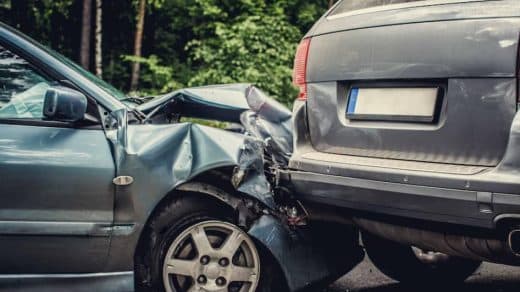After a car accident, you should first call emergency services to report the incident and obtain medical assistance if necessary. Additionally, it’s advisable to contact law enforcement to document the accident officially and, if injuries or disputes arise, reach out to a personal injury lawyer to help navigate legal claims for compensation related to your injuries and damages.
After being involved in a car accident, your immediate reaction might be one of shock or confusion—natural responses amid sudden chaos. It’s vital to stay calm and prioritize everyone’s safety right away. Veteran drivers and first-timers alike can find themselves unsure about what steps to take next. Recognizing this common concern, we’ve taken the time to create a detailed guide crafted with insights from experienced car accident attorneys.

First things first: check for any injuries among yourself and passengers. Even small aches can signify something serious beneath the surface that might develop later. Moving your vehicle to a safe spot can prevent further mishaps on busy roads; do turn on your hazard lights as a clear signal to other drivers. Once you’re safe and collected, it’s important to call emergency services without delay—ensuring that professional help is on its way promptly.
Immediate Steps After a Car Accident
First and foremost, checking for injuries is vital. Before you think about anything else—like exchanging information or assessing vehicle damage—take a moment to breathe and check both yourself and your passengers for any signs of injury.
This includes common issues like neck pain or dizziness, which might not appear immediately but could indicate something more serious. Always remember that it’s better to err on the side of caution; if any person is hurt, don’t hesitate to call emergency services right away. Even if injuries seem minor, seeking medical attention is crucial as some injuries may worsen without prompt treatment.
After ensuring everyone’s well-being, the next step focuses on safety for all involved parties.
If the accident is minor and allows for safe movement, it’s important to move to safety. Keeping in mind that staying put on the road can increase the risk of further accidents, carefully guide your vehicle, if possible, to the shoulder of the road or another safe location.
Once you’ve moved out of harm’s way, turn on your hazard lights to alert other drivers about the situation around you. This simple action can help prevent additional incidents as it signals that something is not quite right ahead.
With everyone out of harm’s way, it’s time to take a closer look at what happened.
Now you can assess the situation. Take a deep breath and allow yourself a moment to collect your thoughts before pointing fingers or jumping to conclusions regarding fault.
Start by evaluating the number and condition of vehicles involved in the accident; take note of any visible damages and relevant road conditions. This can provide valuable insight into how things transpired while keeping emotions in check helps ensure that communication remains calm and constructive.
Following these immediate steps not only promotes safety but also lays the foundation for effective communication between all parties involved. Once you’ve checked injuries, ensured safety, and assessed the situation, it becomes easier to navigate what comes next—such as collecting information for insurance claims or contacting emergency services effectively.
By prioritizing these actions, you set yourself up for a smoother experience when reaching out for assistance in managing your circumstances. With assistance on its way, let’s now explore the best practices when making those emergency calls.
Contacting Emergency Services
Promptly dialing 911 after a car accident is essential for several reasons. First and foremost, it ensures that emergency medical aid reaches the scene as quickly as possible, which is crucial if there are injuries.
To properly report the incident, be ready to give clear and concise details. When the operator answers, take a moment to gather your thoughts and provide them with specific information: the exact location of the accident, the number of vehicles involved, and any visible injuries. For example, stating something like, “There has been a two-car collision at Main Street and Elm; one person appears to be unconscious,” helps them understand the urgency of your situation.
While speaking with the operator, stay calm and avoid rushing through details. Make sure to listen carefully to any questions they may have—answering thoughtfully can ensure that responders are prepared for what they’ll face when they arrive.
Besides alerting emergency medical services, this call will also establish an official record of the incident. This provides vital documentation that can be immensely helpful later on for insurance claims or legal proceedings. Police reports based on 911 calls often serve as an objective account of what took place at the scene.
After ensuring that emergency services are on their way, you may find it necessary to speak with others involved in the accident while waiting for help to arrive or gathering information from witnesses. Understanding how to best communicate in these situations can significantly influence outcomes down the line.
Communicating with Authorities
When officers arrive at the scene of an accident, they take charge of the situation. Your role is to facilitate the investigation by providing clear and accurate information. It’s essential to stay calm and focused during this encounter, as your communication can profoundly influence the outcome of any legal proceedings that may follow.
You should remember that emotions can run high after an accident, but maintaining composure will help ensure you relay information effectively.
Provide Accurate Information
Accuracy is key when speaking to police officers. As you recount the events leading up to the accident, concentrate on sticking strictly to the facts. For instance, refer to specifics such as your speed, direction of travel, and any particular road hazards present at the time.
While it might feel natural to offer explanations or apologize, these statements could unintentionally be interpreted as admissions of fault. Instead, focus on giving details like what you observed before the crash rather than speculating about the actions of others involved.
Obtain Police Reports
Once the initial statements have been made, it’s crucial that you request a copy of the police report once it’s available or at least ask for a report number. This document serves as a vital tool for your insurance claims and any potential legal actions you may need to take later on.
The police report typically includes assessments from responding officers regarding fault and safety concerns observed at the scene, acting as an official record of the incident.
With authorities informed and necessary documentation collected, it’s time to connect with your insurance provider to discuss your next steps.
Informing Insurance Providers
Reporting the accident to your insurance provider is not just a procedural formality; it plays a vital role in ensuring that you receive the financial protection you’re entitled to. As soon as it’s safe to do so, ideally within 24 hours of the incident, call your insurance company to report the accident. Most providers maintain a 24-hour claims hotline, allowing you to initiate this process whenever you need. Providing a detailed account of the accident is crucial, and if you have access to the police report, sharing the report number can substantially streamline their processing.
Timely Reporting
The importance of timely reporting can’t be overstated. Think about this moment as the foundation for your claim. The sooner your insurer knows about the accident, the quicker they can begin assessing any damage and supporting your recovery. Many people find themselves caught up in the aftermath of an accident and forget to make that call. Don’t let that happen! Having important information ready when you call helps gather everything they need efficiently.
Essential Details
- Date and time of the accident
- Location of the accident
- Description of damages
- Contact information of all involved parties
- Police report number (if available)
Having these details on hand isn’t just beneficial; it’s essential. They provide your insurer with a clear picture of what transpired, significantly speeding up their assessment process and minimizing potential disputes down the road. Imagine you’re piecing together a puzzle; each detail contributes to forming a complete image of what happened during that chaotic event.
Claims Process
After notifying your insurance provider, they will guide you through their unique claims process tailored specifically for situations like yours. Expect discussions surrounding damage assessments—this could involve appointments with adjusters who will inspect your vehicle—or conversations about repairs needed. This stage is also where potential compensation for injuries comes into play, which is particularly significant if you or passengers suffered harm during the incident. Throughout this phase, it’s key to ask questions as needed and clarify any uncertainties that arise; remember, it’s their responsibility to inform and assist you.
Besides keeping your insurer informed, understanding your rights and options can greatly enhance your next steps after an accident, especially since legal perspectives may offer additional avenues for accountability and recovery.



